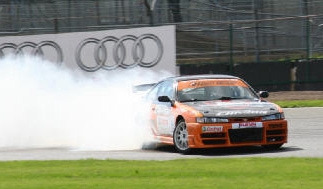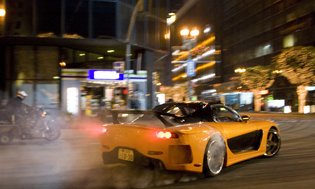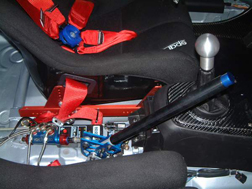There are few things that have captured the automotive world's imagination like drifting. In fact, I can't really think of anything that can hold a candle to it. What seemed like the thing to do around street corners or anytime it rained (even a little bit) has become the Next Big Thing in motorsports, bar none! It's not too difficult to understand why drifting has become a worldwide sensation so quickly: it's almost as much fun for the spectators as it is for the drivers! Ahhh...The Kid loves the smell of burning rubber and the sound of squealing tires!
I love drifting so much, I've decided to write two articles on it. In this article (Part 1), I'll define drifting and give you a quick rundown on several popular drifting techniques. In Part 2 I'll go over all the red meat: what cars are best for drifting, and how to transform your ride into a drifting machine.
 |
| Drifting the track |
Let's get started on the right track and go through the basics first, clearly defining what drifting is exactly. I like to describe it in two simple words: controlled chaos. Those two words alone explain its rise to the top of the popularity scale. Oh, one thing that does need mentioning before we proceed is that drifting is largely limited to rear wheel drive cars. That's a big crowd to exclude, but the very nature of the driving technique goes against the FWD design from the get-go. But don't trade in that Civic just yet-there are ways to do it with FWD cars that I'll discuss a bit later. In drifting, as the car enters a turn the driver intentionally throws the car out of balance by transferring the car's weight to the front wheels, eliminating rear wheel traction. This, in turn, kicks out the rear end, making the car slide sideways. This can be done in a number of ways that I'll review in detail individually. As the car slides into the turn, the driver works the throttle, counter steering, and clutch to keep the car in a controlled, sideways sweep powering all the way through the curve. It's a sight to see, to say the least! A properly performed drift appears as if the car is going to spin out of control, when actually the driver is in complete control at all times. As if watching that once isn't cool enough, it's repeated through a complete race course! Check out some killer drifting videos and catch up on your drifting basics. I've got 'em all!
As if race cars power sliding around a race track isn't cool enough, there's more! Unlike most motorsports events, in drifting the winner isn't necessarily the driver who completes the race the fastest. That'd be just too easy! A drift competition champion is chosen by a panel of judges that grade each driver's performance based on four specific areas. The first is the racing line. Prior to the competition, the judges pre-determine a line for the drivers to follow through a set course. The closer a driver follows the line, the higher his or her score in that area. The second area of assessment is the angle of the car as it sweeps through the curves. A sharp angle and counter steer through the entire turn scores the driver big points. The third thing the judges look for is the speed the driver carries through the curve. Maintaining a high rate of speed throughout the entire length of the turn while following the line at a sharp drift angle is what all drivers strive for. The last evaluation the judges perform is based solely on the driver's individual style on the course. This is the one that sends the crowd into a frenzy (as if the first three weren't enough). Specifically, judges look for smooth transitions from turn to turn with no traction in between, billowing clouds of smoke from spinning tires, and drifting as close to the wall as possible without touching. True drifting champions can bring it all together and make it look easy!
 |
Now equipped with Drifting 101 knowledge, let's dig deeper and get a bit more specific on how to get the car to begin sliding sideways. This is also commonly referred to as oversteer. Oversteer occurs while the car is cornering. It's a loss of rear tire traction while the front tires stay in contact with the road. The back of the car then slides out towards the outside of the turn. The front end of the car points to the inside of the turn "oversteering" (or steering more) than what is needed complete it. So there you have it: drifting is nothing more than a precisely controlled oversteer! Oversteer can be initiated using a number of commonly used drifting techniques. The Braking Drift involves tapping the brakes while entering into a corner, causing the car's weight to transfer to the front. The throttle is then applied immediately which causes the rear wheels to lose traction, and the car to slide out. The Lift-Off or "Kansei" Drift is generally used when entering a high-speed corner. In this maneuver, the driver briefly lifts off the throttle, shifting the weight to the front and producing a mild oversteer. The car is then balanced through the turn using precise steering and throttle control. Another method, the Shift Lock Drift, produces weight transfer and oversteer by downshifting. A quick downshift stresses the driveline and slows the rear tires, thus compromising traction. Similar to the Shift Lock Drift is the Clutch Kick Drift. In this maneuver, the clutch is pushed in and out quickly to jolt the driveline and cause a brief loss of traction. By the way, these last two techniques are rough on the entire drivetrain assembly and should be used with extreme caution. The Inertia or "Feint" Drift produces oversteer by transferring the vehicle's weight not forward, but sideways. By swaying the car toward the outside of a corner, turning away from the corner, then quickly turning back, inertia is created at the rear of the car. Enough sway will swing the car around into a drift. The Dirt Drop Drift involves sliding the rear tires into the dirt while entering a turn to either gain or sustain a sharp drift angle without the loss of speed or power. Another off-track technique is the Jump Drift. Bouncing a rear tire over the curb bordering the inside of a turn will cause a loss of traction, resulting in oversteer.
 |
The last two techniques are reserved for the good old standby, the e-brake. The original Hand-Brake Drift is just that: pull the e-brake to lock up the rear tires, compromise traction, and slide. The Long Slide Drift is exactly the same, except it is performed at high speeds through a long straight to initiate a sharp-angle drift. Remember, when using an e-brake technique the locking mechanism should be removed, preventing the e-brake from locking in place when it's applied. I've seen it happen, and it is damn funny! As I mentioned earlier, FWD cars are limited to e-brake techniques because of their very design. You simply can't use the same wheels to both power and steer the car through a drift. It's either one or the other. The inertia and two e-brake techniques can be used for FWD cars, but without the addition of power they will typically slow the car down so much in the first turn that there won't be enough speed to repeat a similar slide in sequence.
Wow, I just realized that I've listed 9 different ways for you to send your ride into a violent, barely controllable spin. With that, here's my next statement: BE CAREFUL! If you do decide to give one of these blood-pumping moves a try in your ride, take it easy at first, and practice somewhere FAR from anything! Your ride (and your insurance company) will love you for it.
That's it for now. I'll bet your head is swimming with possibilities...and questions. Be sure to read Drifting (Part II) for all the info you need on choosing and modifying cars for drifting.
Peace out!




